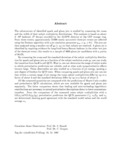Citation link:
https://nbn-resolving.org/urn:nbn:de:hbz:467-1393Files in This Item:
| File | Description | Size | Format | |
|---|---|---|---|---|
| stephan.pdf | 1.52 MB | Adobe PDF |  View/Open | |
| abstract.pdf | 85.9 kB | Adobe PDF |  View/Open |
| Dokument Type: | Doctoral Thesis | metadata.dc.title: | Untersuchung der Substruktur von Quarkjets und Gluonjets aus dem Z 0 -Zerfall | Authors: | Stephan, Frank | Institute: | Fachbereich 7, Physik | Free keywords: | Drei-Jet-Ereignis, ALEPH <Teilchendetektor> | Dewey Decimal Classification: | 530 Physik | GHBS-Clases: | UHXQ | Issue Date: | 1997 | Publish Date: | 2006 | Abstract: | Untersuchung der Substruktur von Quarkjets und Gluonjets aus dem Z 0 -Zerfall The substructure of identified quark and gluon jets is studied by measuring the mean and the width of their subjet multiplicity distributions. This analysis is based on about 3 · 10 6 hadronic Z 0 decays recorded by the ALEPH detector at the LEP storage ring. From these events, approximately 72 000 nearly symmetric three-jet events are selected using the Durham algorithm with a jet resolution parameter y cut = y 1 = 0.1 . The jets are then analyzed using a smaller cut-off y 0 ( y 1 ) so that subjets are resolved. A gluon jet is identified by requiring evidence for long-lived heavy-flavour hadrons in the other two jets of the three-jet event; this results in a sample of 4005 gluon jet candidates with a purity of 94.4%. By measuring the mean and the standard deviation of the subjet multiplicity distribution for quark and gluon jets as a function of the subjet resolution scale y 0 , one can study the transition from hard to soft QCD. That is, one can determine the range of subjet scales in which perturbative predictions are reliable, and at what scale nonperturbative effects become large. These observables are also studied as a function of jet energy, opening a new degree of freedom for QCD tests. When comparing quark and gluon jets one can see that within a certain range of jet energy the mean subjet multiplicities differ by up to a factor of about 3 and the standard deviations differ by up to a factor of about 2. All the measured quantities are compared with the predictions of Monte Carlo models and perturbative QCD calculations, which are now available for quark and gluon jets separately. The latter comparison shows that leading and next-to-leading logarithmic contributions are necessary to extend perturbative descriptions down to lower momentum-transfers. From the comparison of the measured mean subjet multiplicities with a LO( α s +NLLA( y 1 / y 0 ) perturbative prediction the QCD parameters C A , n f T R , and α s are determined, showing good agreement with the standard model values and the world average α s . |
URN: | urn:nbn:de:hbz:467-1393 | URI: | https://dspace.ub.uni-siegen.de/handle/ubsi/139 | License: | https://dspace.ub.uni-siegen.de/static/license.txt |
| Appears in Collections: | Hochschulschriften |
This item is protected by original copyright |
Page view(s)
422
checked on Nov 28, 2024
Download(s)
315
checked on Nov 28, 2024
Google ScholarTM
Check
Items in DSpace are protected by copyright, with all rights reserved, unless otherwise indicated.

